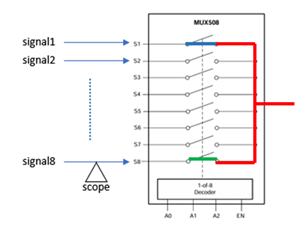Tool/software:
I'm using the MUX508IPWR in my design to switch between multiple analog input sources. The VDD is connected to +12V, VSS is GND. The control lines (A0–A2 and EN) are driven by a 3.3V MCU.
We’re observing an intermittent issue where one channel appears to remain short unexpectedly. This behavior only happens for a long period of time and then the MUX recovers by itself.
My questions are:
-
Under what conditions might the MUX508 exhibit this kind of temporary short or abnormal channel behavior?
-
Could this be caused by internal thermal protection, latch-up, or some kind of internal switching stress?
-
Could this be caused by external pulse, surge or ESD?
Thanks in advance!
for example, green line represent S8 remains short for a long period, and others channel can be switched.






